Timur
| Temür | |
|---|---|
| amir | |
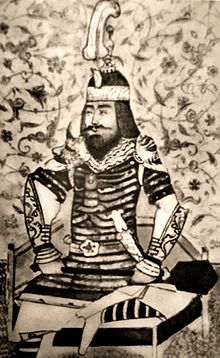 A Timurid-era illustration of Timur | |
| Reign | 9 April 1370– 14 February 1405 |
| Coronation | 9 April 1370, Balkh [1] |
| Predecessor | Amir Hussain |
| Successor | Khalil Sultan |
| Born | 9 April 1336 [1] Kesh, Chagatai Khanate (now in Uzbekistan) |
| Died | 19 February 1405 (aged 68) Otrar, Farab, near Shymkent, Syr Darya (now in Kazakhstan) |
| Burial | |
| Spouse |
|
| Issue | |
| House | Barlas Timurid |
| Father | Muhammad Taraghai |
| Mother | Tekina Mohbegim |
| Religion | Shia Islam |
Timur (Persian: تیمور Timūr, Chagatai: Temür, Uzbek: Temur; 9 April 1336— 18 February 1405), historically known as Tamerlane[2] (Persian: تيمور لنگ Timūr(-e) Lang, "Timur the Lame"), was a Turco-Mongol conqueror and the founder of the Timurid Empire in Persia and Central Asia.[3] He was also the first ruler in the Timurid dynasty.
Born into the Barlas confederation in Transoxiana on 9 April 1336, Timur gained control of the western Chagatai Khanate by 1370. From that base, he led military campaigns across Western, South and Central Asia, Caucasus and southern Russia, and emerged as the most powerful ruler in the Muslim world after defeating the Mamluks of Egypt and Syria, the emerging Ottoman Empire and the declining Delhi Sultanate. From these conquests he founded the Timurid Empire, but this empire fragmented shortly after his death.
Timur is considered the last of the great nomadic conquerors of the Eurasian Steppe, and his empire set the stage for the rise of the more structured and lasting Gunpowder Empires in the 1500s and 1600s.[4][5]: 1 According to John Joseph Saunders, Timur's background was Iranized and not steppe nomad.[6]
Timur envisioned the restoration of the Mongol Empire of Genghis Khan. "In his formal correspondence Temur continued throughout his life to portray himself as the restorer of Chinggisid rights. He justified his Iranian, Mamluk and Ottoman campaigns as a re-imposition of legitimate Mongol control over lands taken by usurpers.[7] To legitimize his conquests, Timur relied on Islamic symbols and language, referred to himself as the 'Sword of Islam' and patronized educational and religious institutions. He converted nearly all the Borjigin leaders to Islam during his lifetime. "Temur, a non-Chinggisid, tried to build a double legitimacy based on his role as both guardian and restorer of the Mongol Empire."[8] Timur also decisively defeated the Christian Knights Hospitaller at Smyrna, styling himself a ghazi.[9]: 91 By the end of his reign, Timur had gained complete control over all the remnants of the Chagatai Khanate, Ilkhanate, and Golden Horde and even attempted to restore the Yuan dynasty.[citation needed]
Timur's armies were inclusively multi-ethnic and were feared throughout Asia, Africa, and Europe,[9] sizable parts of which were laid waste by his campaigns.[10] Scholars estimate that his military campaigns caused the deaths of 17 million people, amounting to about 5% of the world population.[11][12]
He was the grandfather of the renowned Timurid sultan, astronomer and mathematician Ulugh Beg, who ruled Central Asia from 1411 to 1449, and the great-great-great-grandfather of Babur, founder of the Mughal Empire, which ruled parts of South Asia for over three centuries, from 1526 until 1857.[13][14] Timur is also recognized as a great patron of art and architecture, as he interacted with Muslim intellectuals such as Ibn Khaldun and Hafiz-i Abru.[9]: 341–2
Early life

Timur was born in Transoxiana near the city of Kesh (modern Shahrisabz, Uzbekistan) some 80 kilometres (50 mi) south of Samarkand, part of what was then the Chagatai Khanate.[15] His father, Taraqai, was a minor noble of the Barlas,[15] who were Mongols[16][17] that had been Turkified.[18][19][20]
According to Gérard Chaliand, Timur was a Muslim,[21] and he saw himself as Genghis Khan's heir.[21] Though not a Borjigid or a descendent of Genghis Khan,[22] he clearly sought to invoke the legacy of Genghis Khan's conquests during his lifetime.[23]
His name Temur means "Iron" in old Turkic languages (Uzbek Temir, Turkish Demir). Both Timur and Demir are popular male names in Turkey today.[citation needed]
Later Timurid dynastic histories claim that he was born on April 8, 1336, but most sources from his lifetime give ages that are consistent with a birthdate in the late 1320s. Historian Beatrice Forbes Manz suspects the 1336 date was designed to tie Timur to the legacy of Abu Sa'id Bahadur Khan, the last ruler of the Ilkhanate descended from Hulagu Khan, who died in that year.[24]
At the age of eight or nine, Timur and his mother and brothers were carried as prisoners to Samarkand by an invading Mongol army. In his childhood, Timur and a small band of followers raided travelers for goods, especially animals such as sheep, horses, and cattle.[24]: 116 In around 1363, it is believed that Timur tried to steal a sheep from a shepherd but was shot by two arrows, one in his right leg and another in his right hand, where he lost two fingers. Both injuries crippled him for life. Some believe that Timur suffered his crippling injuries while serving as a mercenary to the khan of Sistan in Khorasan in what is today the Dashti Margo in southwest Afghanistan. Timur's injuries have given him the names of Timur the Lame and Tamerlane by Europeans.[9]: 31
Timur was a Muslim, possibly belonging to the Naqshbandi school of Sufism, which was influential in Transoxiana.[25] However, his chief official religious counsellor and adviser was the Hanafi scholar 'Abdu 'l-Jabbar Khwarazmi. In Tirmidh, he had come under the influence of his spiritual mentor Sayyid Baraka, a leader from Balkh who is buried alongside Timur in Gur-e-Amir.[26][27][28] Timur was known to hold Ali and the Ahl al-Bayt in high regard and has been noted by various scholars for his "pro-Alid" stance. Despite this, Timur was noted for attacking the Shia with Sunni apologism.[29]
Personality

Timur is regarded as a military genius, and as a brilliant tactician with an uncanny ability to work within a highly fluid political structure to win and maintain a loyal following of nomads during his rule in Central Asia. He was also considered extraordinarily intelligent – not only intuitively but also intellectually.[5]: 16 In Samarkand and his many travels, Timur, under the guidance of distinguished scholars, was able to learn the Persian, Mongolian, and Turkic languages.[9]: 9 More importantly, Timur was characterized as an opportunist. Taking advantage of his Turco-Mongolian heritage, Timur frequently used either the Islamic religion or the law and traditions of the Mongol Empire to achieve his military goals or domestic political aims.[9]
Military leader
This section needs additional citations for verification. (December 2015) |
About 1360 Timur gained prominence as a military leader whose troops were mostly Turkic tribesmen of the region.[21] He took part in campaigns in Transoxiana with the Khan of the Chagatai Khanate. Allying himself both in cause and by family connection with Kurgan, the dethroner and destroyer of Volga Bulgaria, he invaded Khorasan[30] at the head of a thousand horsemen. This was the second military expedition that he led, and its success led to further operations, among them the subjugation of Khwarezm and Urgench.
Following Kurgan's murder, disputes arose among the many claimants to sovereign power. Khan of Eastern Chagatai Khanate Tughlugh Timur of Kashgar, another descendant of Genghis Khan, invaded, interrupting this infighting. Timur was sent to negotiate with the invader but joined with him instead and was rewarded with Transoxania. At about this time his father died and Timur became chief of the Berlas as well. Tughlugh then attempted to set his son Ilyas Khoja over Transoxania, but Timur repelled this invasion with a smaller force.[30]
Rise to power

It was in this period that Timur reduced the Chagatai khans to the position of figureheads while he ruled in their name. Also during this period, Timur and his brother-in-law Husayn, who were at first fellow fugitives and wanderers in joint adventures, became rivals and antagonists. The relationship between them began to become strained after Husayn abandoned efforts to carry out Timur's orders to finish off Ilya Khoja (former governor of Mawarannah) close to Tishnet.[9]: 40
Timur began to gain a following of people in Balkh, consisting of merchants, fellow tribesmen, Muslim clergy, aristocracy and agricultural workers, because of his kindness in sharing his belongings with them. This contrasted Timur's behavior with that of Husayn, who alienated these people, took many possessions from them via his heavy tax laws and selfishly spent the tax money building elaborate structures.[9]: 41–2 At around 1370 Husayn surrendered to Timur and was later assassinated, which allowed Timur to be formally proclaimed sovereign at Balkh. He married Husayn's wife Saray Mulk Khanum, a descendant of Genghis Khan, allowing him to become imperial ruler of the Chaghatay tribe.[9]
One day Aksak Temür spoke thusly:
"Khan Züdei (in China) rules over the city. We now number fifty to sixty men, so let us elect a leader." So they drove a stake into the ground and said: "We shall run thither and he among us who is the first to reach the stake, may he become our leader". So they ran and Aksak Timur, as he was lame, lagged behind, but before the others reached the stake he threw his cap onto it. Those who arrived first said: "We are the leaders." ["But,"] Aksak Timur said: "My head came in first, I am the leader." Meanwhile, an old man arrived and said: "The leadership should belong to Aksak Timur; your feet have arrived but, before then, his head reached the goal." So they made Aksak Timur their prince.[31][32]
Legitimization of Timur's rule

Timur's Turco-Mongolian heritage provided opportunities and challenges as he sought to rule the Mongol Empire and the Muslim world. According to the Mongol traditions, Timur could not claim the title of khan or rule the Mongol Empire because he was not a descendant of Genghis Khan. Therefore, Timur set up a puppet Chaghatay khan, Suyurghatmish, as the nominal ruler of Balkh as he pretended to act as a "protector of the member of a Chinggisid line, that of Genghis Khan's eldest son, Jochi".[33]
As a result, Timur never used the title of khan because the name khan could only be used by those who come from the same lineage as Genghis Khan himself. Timur instead used the title of amir meaning general, and acting in the name of the Chagatai ruler of Transoxania.[24]: 106
To reinforce his position in the Mongol Empire, Timur managed to acquire the royal title of son-in-law when he married a princess of Chinggisid descent.[5]: 14
Likewise, Timur could not claim the supreme title of the Islamic world, caliph, because the "office was limited to the Quraysh, the tribe of the Prophet Muhammad". Therefore, Timur reacted to the challenge by creating a myth and image of himself as a "supernatural personal power" ordained by God.[33] Since Timur had a successful career as a conqueror, it was easy to justify his rule as ordained and favored by God since no ordinary man could be a possessor of such good fortune that resistance would be seen as opposing the will of God. Moreover, the Islamic notion that military and political success was the result of Allah's favor had long been successfully exploited by earlier rulers. Therefore, Timur's assertions would not have seemed unbelievable to fellow Islamic people.
Period of expansion
Timur spent the next 35 years in various wars and expeditions. He not only consolidated his rule at home by the subjugation of his foes, but sought extension of territory by encroachments upon the lands of foreign potentates. His conquests to the west and northwest led him to the lands near the Caspian Sea and to the banks of the Ural and the Volga. Conquests in the south and south-West encompassed almost every province in Persia, including Baghdad, Karbala and Northern Iraq.
One of the most formidable of Timur's opponents was another Mongol ruler, a descendant of Genghis Khan named Tokhtamysh. After having been a refugee in Timur's court, Tokhtamysh became ruler both of the eastern Kipchak and the Golden Horde. After his accession, he quarreled with Timur over the possession of Khwarizm and Azerbaijan. However, Timur still supported him against the Russians and in 1382 Tokhtamysh invaded the Muscovite dominion and burned Moscow.[34]
Conquest of Persia



After the death of Abu Sa'id, ruler of the Ilkhanate, in 1335, there was a power vacuum in Persia. In the end Persia was split amongst the Muzaffarids, Kartids, Eretnids, Chobanids, Injuids, Jalayirids, and Sarbadars. In 1383, Timur started his lengthy military conquest of Persia, though he already ruled over much of Persian Khorasan by 1381, after Khwaja Mas'ud, of the Sarbadar dynasty surrendered. Timur began his Persian campaign with Herat, capital of the Kartid dynasty. When Herat did not surrender he reduced the city to rubble and massacred most of its citizens; it remained in ruins until Shahrukh Mirza ordered it's reconstruction.[35] Timur sent a General to capture rebellious Kandahar. With the capture of Herat the Kartid kingdom surrendered and became vassals of Timur, but it would later be annexed in 1389 by Timur's son Miran Shah.
Timur then headed west to capture the Zagros Mountains, passing through Mazandaran. During his travel through the north of Persia, he captured the then town of Tehran, which surrendered and was thus treated mercifully. He laid siege to Soltaniyeh in 1384. Khorasan revolted one year later, so Timur destroyed Isfizar, and the prisoners were cemented into the walls alive. The next year the kingdom of Sistan, under the Mihrabanid dynasty, was ravaged, and its capital at Zaranj was destroyed. Timur then returned to his capital of Samarkand, where he began planning for his Georgian campaign and Golden Horde invasion. In 1386 Timur passed through Mazandaran as he had when trying to capture the Zagros. He went near the city of Soltaniyeh, which he had previously captured but instead turned north and captured Tabriz with little resistance, along with Maragha. He ordered heavy taxation of the people, which was collected by Adil Aqa, who was also given control over Soltaniyeh. Adil was later executed because Timur suspected him of corruption.
Timur then went north to begin his Georgian and Golden Horde campaigns, pausing his full-scale invasion of Persia. When he returned he found his generals had done well in protecting the cities and lands he had conquered in Persia. Though many rebelled, and his son Miran Shah, who may have been regent, was forced to annex rebellious vassal dynasties, his holdings remained. So he proceeded to capture the rest of Persia, specifically the two major southern cities of Isfahan and Shiraz. When he arrived with his army at Isfahan in 1387, the city immediately surrendered; he treated it with relative mercy as he normally did with cities that surrendered (unlike Herat). However, after Isfahan revolted against Timur's taxes by killing the tax collectors and some of Timur's soldiers, he ordered the massacre of the city's citizens; the death toll is reckoned at between 100,000 and 200,000.[36] An eye-witness counted more than 28 towers constructed of about 1,500 heads each.[37] This has been described as a "systematic use of terror against towns...an integral element of Tamerlane's strategic element", which he viewed as preventing bloodshed by discouraging resistance. His massacres were selective and he spared the artistic and educated. This would later influence the next great Persian conqueror: Nader Shah.[36]
Timur then began a five-year campaign to the west in 1392, attacking Persian Kurdistan. In 1393, Shiraz was captured after surrendering, and the Muzaffarids became vassals to Timur, though prince Shah Mansur rebelled but was defeated, and the Muzafarids were annexed. Shortly after Georgia was devastated so that the Golden Horde could not use it to threaten northern Iran. In the same year Timur caught Baghdad by surprise in August by marching there in only eight days from Shiraz. Sultan Ahmad Jalayir fled to Syria, where the Mamluk Sultan Barquq protected him and killed Timur’s envoys. Timur left the Sarbadar prince Khwaja Mas'ud to govern Baghdad, but he was driven out when Ahmad Jalayir returned. Ahmad was unpopular but got some dangerous help from Qara Yusuf of the Kara Koyunlu; he fled again in 1399, this time to the Ottomans.
Tokhtamysh–Timur war
In the meantime Tokhtamysh, now khan of the Golden Horde, turned against his patron and in 1385 invaded Azerbaijan. The inevitable response by Timur resulted in the Tokhtamysh–Timur war. In the initial stage of the war Timur won a victory at the Battle of the Kondurcha River. After the battle Tokhtamysh and some of his army were allowed to escape. After Tokhtamysh's initial defeat Timur invaded Muscovy to the north of Tokhtamysh's holdings. Timur's army burned Ryazan and advanced on Moscow. He was pulled away before reaching the Oka River by Tokhtamysh's renewed campaign in the south.[38]
In the first phase of the conflict with Tokhtamysh, Timur led an army of over 100,000 men north for more than 700 miles into the steppe. He then rode west about 1,000 miles advancing in a front more than 10 miles wide. During this advance Timur's army got far enough north to be in a region of very long summer days causing complaints by his Muslim soldiers about keeping a long schedule of prayers. It was then that Tokhtamysh's army was boxed in against the east bank of the Volga River in the Orenburg region and destroyed at the Battle of the Kondurcha River, in 1391.
In the second phase of the conflict Timur took a different route against the enemy by invading the realm of Tokhtamysh via the Caucasus region. In 1395 Timur defeated Tokhtamysh in the Battle of the Terek River, concluding the struggle between the two monarchs. Tokhtamysh was unable to restore his power or prestige, and he was killed about a decade later in the area of present-day Tyumen. During the course of Timur's campaigns his army destroyed Sarai, the capital of the Golden Horde, and Astrakhan, subsequently disrupting the Golden Horde's Silk Road. The Golden Horde no longer held power after their losses to Timur.
Ismailis
In May 1393 Timur's army invaded the Anjudan, crippling the Ismaili village only a year after his assault on the Ismailis in Mazandaran. The village was prepared for the attack, evidenced by its fortress and system of underground tunnels. Undeterred, Timur's soldiers flooded the tunnels by cutting into a channel overhead. Timur's reasons for attacking this village are not yet well understood. However, it has been suggested that his religious persuasions and view of himself as an executor of divine will may have contributed to his motivations.[39] The Persian historian Khwandamir explains that an Ismaili presence was growing more politically powerful in Persian Iraq. A group of locals in the region was dissatisfied with this and, Khwandamir writes, these locals assembled and brought up their complaint with Timur, possibly provoking his attack on the Ismailis there.[39]
Campaign against the Tughlaq Dynasty

In 1398, Timur invaded northern India, attacking the Delhi Sultanate ruled by Sultan Nasir-ud-Din Mahmud Shah Tughluq of the Tughlaq Dynasty. He was opposed by Ahirs and Jats but the Sultanate at Delhi did nothing to stop him.[40] After crossing the Indus river on 30 September 1398, he sacked Tulamba and massacred its inhabitants.[41] Then he advanced and captured Multan by October.[42]
Timur crossed the Indus River at Attock (now Pakistan) on 24 September 1398. His invasion did not go unopposed and he encountered resistance by the Governor of Meerut during the march to Delhi. Timur was still able to continue his approach to Delhi, arriving in 1398, to fight the armies of Sultan Nasir-ud-Din Mahmud Shah Tughluq, which had already been weakened by a succession struggle within the royal family.
Capture of Delhi (1398)
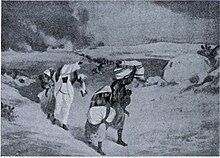
The battle took place on 17 December 1398. Sultan Nasir-ud-Din Mahmud Shah Tughluq and the army of Mallu Iqbal[43] had war elephants armored with chain mail and poison on their tusks.[9]: 267 As his Tatar forces were afraid of the elephants, Timur ordered his men to dig a trench in front of their positions. Timur then loaded his camels with as much wood and hay as they could carry. When the war elephants charged, Timur set the hay on fire and prodded the camels with iron sticks, causing them to charge at the elephants howling in pain: Timur had understood that elephants were easily panicked. Faced with the strange spectacle of camels flying straight at them with flames leaping from their backs, the elephants turned around and stampeded back toward their own lines. Timur capitalized on the subsequent disruption in the forces of Nasir-ud-Din Mahmud Shah Tughluq, securing an easy victory. Nasir-ud-Din Mahmud Shah Tughluq fled with remnants of his forces. Delhi was sacked and left in ruins. Before the battle for Delhi, Timur executed 100,000 captives.[14]
The capture of the Delhi Sultanate was one of Timur's greatest victories, arguably surpassing the likes of Alexander the Great and Genghis Khan because of the harsh conditions of the journey and the achievement of taking down one of the richest cities at the time. After Delhi fell to Timur's army, uprisings by its citizens against the Turkic-Mongols began to occur, causing a bloody massacre within the city walls. After three days of citizens uprising within Delhi, it was said that the city reeked of the decomposing bodies of its citizens with their heads being erected like structures and the bodies left as food for the birds. Timur's invasion and destruction of Delhi continued the chaos that was still consuming India, and the city would not be able to recover from the great loss it suffered for almost a century.[9]: 269–274
Campaigns in the Levant

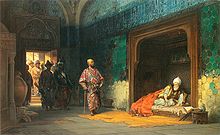
Before the end of 1399, Timur started a war with Bayezid I, sultan of the Ottoman Empire, and the Mamluk sultan of Egypt Nasir-ad-Din Faraj. Bayezid began annexing the territory of Turkmen and Muslim rulers in Anatolia. As Timur claimed sovereignty over the Turkmen rulers, they took refuge behind him.
In 1400 Timur invaded Christian Armenia and Georgia. Of the surviving population, more than 60,000 of the local people were captured as slaves, and many districts were depopulated.[44]
Then Timur turned his attention to Syria, sacking Aleppo[45][46] and Damascus.[47][48][49][50] The city's inhabitants were massacred, except for the artisans, who were deported to Samarkand. Timur cited the killing of Hasan ibn Ali by Umayyad caliph Muawiyah I and the killing of Husayn ibn Ali by Yazid I as the reason for his massacre of the inhabitants of Damascus.
Timur invaded Baghdad in June 1401. After the capture of the city, 20,000 of its citizens were massacred. Timur ordered that every soldier should return with at least two severed human heads to show him. When they ran out of men to kill, many warriors killed prisoners captured earlier in the campaign, and when they ran out of prisoners to kill, many resorted to beheading their own wives.[51]
In the meantime, years of insulting letters had passed between Timur and Bayezid. Finally, Timur invaded Anatolia and defeated Bayezid in the Battle of Ankara on 20 July 1402. Bayezid was captured in battle and subsequently died in captivity, initiating the twelve-year Ottoman Interregnum period. Timur's stated motivation for attacking Bayezid and the Ottoman Empire was the restoration of Seljuq authority. Timur saw the Seljuks as the rightful rulers of Anatolia as they had been granted rule by Mongol conquerors, illustrating again Timur's interest with Genghizid legitimacy.
After the Ankara victory, Timur's army ravaged Western Anatolia, with Muslim writers complaining that the Timurid army acted more like a horde of savages than that of a civilized conqueror.[citation needed] But Timur did take the city of Smyrna, a stronghold of the Christian Knights Hospitalers, thus he referred to himself as ghazi or "Warrior of Islam". A mass beheading was carried out in Smyrna by Timur's soldiers.[52][53][54][55]
Timur was furious at the Genoese and Venetians whose ships ferried the Ottoman army to safety in Thrace. As Lord Kinross reported in The Ottoman Centuries, the Italians preferred the enemy they could handle to the one they could not.
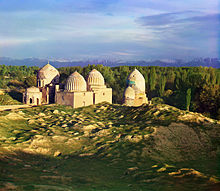
While Timur invaded Anatolia, Qara Yusuf assaulted Baghdad and captured it in 1402. Timur returned to Persia from Anatolia and sent his grandson Abu Bakr ibn Miran Shah to reconquer Baghdad, which he proceeded to do. Timur then spent some time in Ardabil, where he gave Ali Safavi, leader of the Safaviyya, a number of captives. Subsequently, he marched to Khorasan and then to Samarkhand, where he spent nine months celebrating and preparing to invade Mongolia and China.[56]
He ruled over an empire that, in modern times, extends from southeastern Turkey, Syria, Iraq, and Iran, through Central Asia encompassing part of Kazakhstan, Afghanistan, Armenia, Azerbaijan, Georgia, Turkmenistan, Uzbekistan, Kyrgyzstan, Pakistan, and even approaches Kashgar in China. The conquests of Timur are claimed to have caused the deaths of up to 17 million people, an assertion impossible to verify.[57]
Of Timur's four sons, two (Jahangir and Umar Shaikh) predeceased him. His third son, Miran Shah, died soon after Timur, leaving the youngest son, Shah Rukh. Although his designated successor was his grandson Pir Muhammad b. Jahangir, Timur was ultimately succeeded in power by his son Shah Rukh. His most illustrious descendant Babur founded the Islamic Mughal Empire and ruled over most of Afghanistan and North India. Babur's descendants Humayun, Akbar, Jahangir, Shah Jahan and Aurangzeb, expanded the Mughal Empire to most of the Indian subcontinent.
Markham, in his introduction to the narrative of Clavijo's embassy, states that after Timur died, his body "was embalmed with musk and rose water, wrapped in linen, laid in an ebony coffin and sent to Samarkand, where it was buried". His tomb, the Gur-e Amir, still stands in Samarkand, though it has been heavily restored in recent years.
Attempts to attack the Ming dynasty

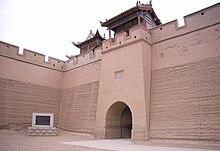
By 1368, Han Chinese forces had driven the Mongols out of China. The first of the new Ming dynasty's emperors, the Hongwu Emperor, and his son, the Yongle Emperor, demanded and received homage from many Central Asian states as the political heirs to the former House of Kublai. The Ming emperors' treatment of Timur as a vassal did not sit well with the conqueror. In 1394 Hongwu's ambassadors eventually presented Timur with a letter addressing him as a subject. He summarily had the ambassadors Fu An, Guo Ji, and Liu Wei detained, and had the 1500 guards executed.[59] Neither Hongwu's next ambassador, Chen Dewen (1397), nor the delegation announcing the accession of the Yongle Emperor fared any better.[59]
Timur eventually planned to conquer China. To this end Timur made an alliance with the Northern Yuan dynasty based in Mongolia and prepared all the way to Bukhara. Engke Khan sent his grandson Öljei Temür Khan, also known as "Buyanshir Khan" after he converted to Islam while at the court of Timur in Samarkand.[60]
Timur preferred to fight his battles in the spring. However, he died en route during an uncharacteristic winter campaign. In December 1404, Timur began military campaigns against Ming China and detained a Ming envoy. He suffered illness while encamped on the farther side of the Syr Daria and died at Farab on February 17, 1405,[61] before ever reaching the Chinese border.[62] After his death the Ming envoys such as Fu An and the remaining entourage were released[59] by his grandson Khalil Sultan.
Succession
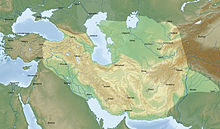
Just before his death, Timur designated his grandson Pir Muhammad ibn Jahangir as his successor. However, his other descendants did not abide by this wish, and spent the next fifteen years engaged in violent infighting. His son Shahrukh Mirza and grandson Khalil Sultan struggled for control until Shahrukh won.
Exchanges with Europe

Timur had numerous epistolary and diplomatic exchanges with various European states, especially Spain and France. Relations between the court of Henry III of Castile and that of Timur played an important part in medieval Castilian diplomacy. In 1402, the time of the Battle of Ankara, two Spanish ambassadors were already with Timur: Pelayo de Sotomayor and Fernando de Palazuelos. Later, Timur sent to the court of the Kingdom of León and Castile a Chagatai ambassador named Hajji Muhammad al-Qazi with letters and gifts.
In return, Henry III of Castile sent a famous embassy to Timur's court in Samarkand in 1403–06, led by Ruy González de Clavijo, with two other ambassadors, Alfonso Paez and Gomez de Salazar. On their return, Timur affirmed that he regarded the king of Castile "as his very own son".
According to Clavijo, Timur's good treatment of the Spanish delegation contrasted with the disdain shown by his host toward the envoys of the "lord of Cathay" (i.e., the Yongle Emperor), the Chinese ruler. Clavijo's visit to Samarkand allowed him to report to the European audience on the news from Cathay (China), which few Europeans had been able to visit directly in the century that had passed since the travels of Marco Polo.
The French archives preserve:
- A 30 July 1402 letter from Timur to Charles VI of France, suggesting that he send traders to Asia. It is written in Persian.[63]
- A May 1403 letter. This is a Latin transcription of a letter from Timur to Charles VI, and another from Miran Shah, his son, to the Christian princes, announcing their victory over Bayezid I at Smyrna.[64]
A copy has been kept of the answer of Charles VI to Timur, dated 15 June 1403.[65]
Legacy
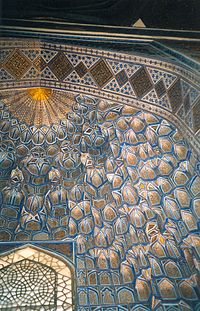
Timur's legacy is a mixed one. While Central Asia blossomed under his reign, other places such as Baghdad, Damascus, Delhi and other Arab, Georgian, Persian, and Indian cities were sacked and destroyed and their populations massacred. He was responsible for the effective destruction of the Nestorian Christian Church of the East in much of Asia. Thus, while Timur still retains a positive image in Muslim Central Asia, he is vilified by many in Arabia, Iraq, Persia, and India, where some of his greatest atrocities were carried out. However, Ibn Khaldun praises Timur for having unified much of the Muslim world when other conquerors of the time could not.[66] The next great conqueror of the middle east, Nader Shah, was greatly influenced by Timur and almost re-enacted Timur's conquests and battle strategies in his own campaigns. Like Timur, Nader Shah conquered most of Caucasia, Persia, and Central Asia along with also sacking Delhi.
Timur's short-lived empire also melded the Turko-Persian tradition in Transoxiana, and in most of the territories which he incorporated into his fiefdom, Persian became the primary language of administration and literary culture (diwan), regardless of ethnicity.[67] In addition, during his reign, some contributions to Turkic literature were penned, with Turkic cultural influence expanding and flourishing as a result. A literary form of Chagatai Turkic came into use alongside Persian as both a cultural and an official language.[68]
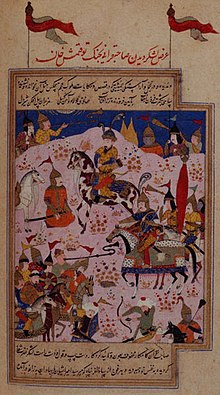
Tamerlane virtually exterminated the Church of the East, which had previously been a major branch of Christianity but afterwards became largely confined to a small area now known as the Assyrian Triangle.[69]
Timur became a relatively popular figure in Europe for centuries after his death, mainly because of his victory over the Ottoman Sultan Bayezid. The Ottoman armies were at the time invading Eastern Europe and Timur was ironically seen as an ally.
Timur has now been officially recognized as a national hero in Uzbekistan. His monument in Tashkent now occupies the place where Karl Marx's statue once stood.
Muhammad Iqbal, a philosopher, poet and politician in British India who is widely regarded as having inspired the Pakistan Movement,[70][better source needed] composed a notable poem entitled Dream of Timur, the poem itself was inspired by a prayer of the last Mughal emperor, Bahadur Shah II:[citation needed]
The Sharif of the Hijaz suffers due to the divisive sectarian schisms of his faith, And lo! that young Tatar (Timur) has boldly re-envisioned magnanimous victories of overwhelming conquest.
In 1794, Sake Dean Mahomed published his travel book, The Travels of Dean Mahomet. The book begins with the praise of Genghis Khan, Timur, and particularly the first Mughal emperor, Babur. He also gives important details on the then incumbent Mughal Emperor Shah Alam II.
Historical sources

The earliest known history of his reign was Nizam ad-Din Shami's Zafarnama, which was written during Timur's lifetime. Between 1424 and 1428, Sharaf ad-Din Ali Yazdi wrote a second Zafarnama drawing heavily on Shami's earlier work. Ahmad ibn Arabshah wrote a much less favorable history in Arabic. Arabshah's history was translated by the Dutch Orientalist Jacobus Golius in 1636.
As Timurid-sponsored histories, the two Zafarnamas present a dramatically different picture from Arabshah's chronicle. William Jones remarked that the former presented Timur as a "liberal, benevolent and illustrious prince" while the latter painted him as "deformed and impious, of a low birth and detestable principles".[citation needed]
Malfuzat-i Timuri
The Malfuzat-i Timurī and the appended Tuzūk-i Tīmūrī, supposedly Timur's own autobiography, are almost certainly 17th century fabrications.[14][71] The scholar Abu Taleb Hosayni presented the texts to the Mughal emperor Shah Jahan, a distant descendant of Timur, in 1637–38, supposedly after discovering the Chagatai language originals in the library of a Yemeni ruler. Due to the distance between Yemen and Timur's base in Transoxiana and the lack of any other evidence of the originals, most historians consider the story highly implausible and suspect Hosayni of inventing both the text and its origin story.[71]
European views
Timur arguably had a significant impact on the Renaissance culture and early modern Europe.[72] His achievements both fascinated and horrified Europeans from the fifteenth century to the early nineteenth century.
European views of Timur were mixed throughout the fifteenth century, with some European countries calling him an ally and others seeing him as a threat to Europe because of his rapid expansion and brutality.[73]: 341
When Timur captured the Ottoman Sultan Bayezid at Ankara, he was often praised and seen as a trusted ally by European rulers such as Charles VI of France and Henry IV of England because they believed he was saving Christianity from the Turkish Empire in the Middle East. Those two kings also praised him because his victory at Ankara allowed Christian merchants to remain in the Middle East and allowed for their safe return home to both France and England. Timur was also praised because it was believed that he helped restore the right of passage for Christian pilgrims to the Holy Land.[73]: 341–44
Other Europeans viewed Timur as a barbaric enemy who presented a threat to both European culture and the religion of Christianity. His rise to power moved many leaders, such as Henry III of Castile, to send embassies to Samarkand to scout out Timur, learn about his people, make alliances with him, and try to convince him to convert to Christianity in order to avoid war.[73]: 348–49
In the introduction to a 1723 translation of Yazdi's Zafarnama, the translator wrote:[74]
[M. Petis de la Croix] tells us, that there are calumnies and impostures, which have been published by authors of romances, and Turkish writers who were his enemies, and envious at his glory: among whom is Ahmed Bin Arabschah…As Timur-Bec had conquered the Turks and Arabians of Syria, and had even taken the Sultan Bajazet prisoner, it is no wonder that he has been misrepresented by the historians of those nations, who, in despite of truth, and against the dignity of history, have fallen into great excesses on this subject.
Exhumation and alleged curse
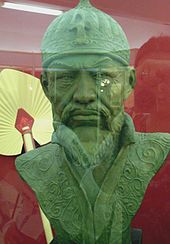
Timur's body was exhumed from his tomb on 19 June 1941 and his remains examined by the Soviet anthropologist Mikhail M. Gerasimov, Lev V. Oshanin and V. Ia. Zezenkova. It was determined that Timur was a tall and broad-chested man with strong cheek bones. At 5 feet 8 inches (1.73 meters), Timur was tall for his era. The examinations confirmed that Timur was lame and had a withered right arm due to his injuries. His right thighbone had knitted together with his kneecap, and the configuration of the knee joint suggests that he had kept his leg bent at all times and therefore would have had a pronounced limp.[75][76] Gerasimov reconstructed the likeness of Timur from his skull and found that Timur's facial characteristics displayed Mongoloid features with some Caucasoid admixture. Oshanin also concluded that Timur's cranium showed predominately the characteristics of a South Siberian Mongoloid type.[76]
It is alleged that Timur's tomb was inscribed with the words, "When I rise from the dead, the world shall tremble." It is also said that when Gerasimov exhumed the body, an additional inscription inside the casket was found, which read, "Whomsoever opens my tomb shall unleash an invader more terrible than I."[77] In any case, three days after Gerasimov began the exhumation, Adolf Hitler launched Operation Barbarossa, the largest military invasion of all time, upon the Soviet Union.[78] Timur was re-buried with full Islamic ritual in November 1942 just before the Soviet victory at the Battle of Stalingrad.[79]
In the arts
- Tamburlaine the Great, Parts I and II (English, 1563–1594): play by Christopher Marlowe
- Tamerlane (1701): play by Nicholas Rowe (English)
- Tamerlano (1724): opera by George Frideric Handel, in Italian, based on the 1675 play Tamerlan ou la mort de Bajazet by Jacques Pradon.
- Bajazet (1735): opera by Antonio Vivaldi, portrays the capture of Bayezid I by Timur
- Il gran Tamerlano (1772): opera by Josef Mysliveček that also portrays the capture of Bayezid I by Timur
- Tamerlane: first published poem of Edgar Allan Poe (American, 1809–1849).
- Timur is the deposed, blind former King of Tartary and father of the protagonist Calaf in the opera Turandot (1924) by Giacomo Puccini, libretto by Giuseppe Adami and Renato Simoni.
- Timour appears in the story Lord of Samarkand by Robert E. Howard.
- Tamerlan: novel by Colombian writer Enrique Serrano in Spanish[80]
- Tamburlaine: Shadow of God: a BBC Radio 3 play by John Fletcher, broadcast 2008, is a fictitious account of an encounter between Tamburlaine, Ibn Khaldun, and Hafez.
- Tamerlane (1928): historical novel by Harold Lamb.
Gallery
-
Geometric courtyard surrounding the tomb showing the Iwan, and dome.
-
View of the Registan.
-
Timurid Mosque in Herat.
-
Goharshad Mosque, Timurid architecture
-
Green Mosque (Balkh) is a Timurid mosque that inspired Shah Jahan.
-
Mausoleum of Khoja Ahmed Yasawi, a prime example of Timurid architecture.
Consorts
Timur married six times and had many concubines:
- Turmish Agha, daughter of Amir Jaku Barlas;
- Aljaz Turkhan Agha (m. 1357/58), daughter of Amir Mashlah and granddaughter of Amir Kurgen;
- Saray Mulk Khanum (m. 1367), widow of Emir Husain Khan, daughter of Khazan Khan;
- Dilshad Agha (m. 1374), daughter of Shams ed-Din and his wife Bujan Agha;
- Touman Agha (m. 1377), daughter of Emir Musa and his wife Arzu Mulk Agha;
- Chulpan Mulk Agha, daughter of Haji Bey of Jetah;
- Tukal Khanum (m. 1395), daughter of Mongol Khan Khizr Khawaja Aglen;
- Tolun Agha, concubine and mother of Umar Shaikh Mirza I;
- Mengli Agha, concubine and mother of Miran Shah ibn Timur;
- Toghay Turkhan Agha, concubine and mother of Shahrukh Mirza ibn Timur.
Descendants of Timur
Sons of Timur
- Jahangir Mirza ibn Timur - with Turmish Agha;
- Umar Shaikh Mirza I - with Tolun Agha;
- Miran Shah ibn Timur - with Mengli Agha;
- Shahrukh Mirza ibn Timur - with Toghay Turkhan Agha;
- Khalil Sultan ibn Timur - with Saray Mulk Khanum.
Daughters of Timur
- Akia Beghi, married to Mohammad Bey, son of Amir Musa - mother unknown;
- unknown, married to Solyman Mirza - mother unknown;
- unknown, married to Cumaleza Mirza - mother unknown;
- Sultan Bakht Begum, married firstly Mohammed Mireke, married secondly, 1389/90, Soliman Shah- with Aljaz Turkhan Agha.
Sons of Jahangir
Sons of Umar Shaikh Mirza I
- Pir Muhammad ibn Umar Shaikh Mirza I
- Iskandar ibn Umar Shaikh Mirza I
- Rustam ibn Umar Shaikh Mirza I
- Bayqarah ibn Umar Shaikh Mirza I
- Mansur ibn Bayqarah
- Husayn ibn Mansur bin Bayqarah
- Badi' al-Zaman
- Muhammed Mu'min
- Muzaffar Hussein
- Ibrahim Hussein
- Badi' al-Zaman
- Husayn ibn Mansur bin Bayqarah
- Mansur ibn Bayqarah
Sons of Miran Shah
- Khalil Sultan ibn Miran Shah
- Abu Bakr ibn Miran Shah
- Muhammad ibn Miran Shah
- Abu Sa'id Mirza
- Umar Shaikh Mirza II
- Zahir-ud-din Muhammad Babur
- the Mughals
- Jahangir Mirza II
- Zahir-ud-din Muhammad Babur
- Umar Shaikh Mirza II
- Abu Sa'id Mirza
Sons of Shahrukh Mirza
- Mirza Muhammad Taraghay – better known as Ulugh Beg
- Ghiyath-al-Din Baysonqor
- Ala-ud-Daulah Mirza ibn Baysonqor
- Sultan Muhammad ibn Baysonqor
- Mirza Abul-Qasim Babur ibn Baysonqor
- Sultan Ibrahim Mirza
- Mirza Soyurghatmïsh Khan
- Mirza Mohammed Juki
See also
- Timurid dynasty
- Ahmad Jalayir
- Global Empire
- List of the Muslim Empires
- Muslim conquest in the Indian subcontinent
- Tamburlaine (play)
- Harold Lamb, author of the historical novel Tamerlane (1928)
- Taimur, an intercontinental ballistic missile speculated as being developed by Pakistan, named after Timur
- Tamerlane chess
- Timurlengia
Notes
- ^ a b Muntakhab-ul-Lubab, Khafi Khan Nizam-ul-Mulk, Vol I, p. 49. Printed in Lahore, 1985
- ^ /ˈtæmərleɪn/
- ^ Josef W. Meri (2005). Medieval Islamic Civilization. Routledge. p. 812.
- ^ Darwin, John (2008). After Tamerlane: the rise and fall of global empires, 1400-2000. Bloomsbury Press. pp. 29, 92. ISBN 9781596917606.
- ^ a b c Manz, Beatrice Forbes (1989). The rise and rule of Tamerlane. Cambridge University Press.
- ^ J. J. Saunders (1 March 2001). The History of the Mongol Conquests. University of Pennsylvania Press. pp. 173–. ISBN 0-8122-1766-7.
- ^ Forbes Manz, Beatrice (April 1998). "Temür and the Problem of a Conqueror's Legacy". Journal of the Royal Asiatic Society. Third. 8 (1): 25. JSTOR 25183464.
- ^ Biran, Michal (October 2002). "The Chaghadaids and Islam: The Conversion of Tarmashirin Khan (1331-34)". Journal of the American Oriental Society. 122 (4): 742–752. doi:10.2307/3217613.
- ^ a b c d e f g h i j k Marozzi, Justin (2004). Tamerlane: Sword of Islam, conqueror of the world. HarperCollins.
- ^ Matthew White: Atrocitology: Humanity's 100 Deadliest Achievements, Canongate Books, 2011, ISBN 9780857861252, section "Timur"
- ^ "The Rehabilitation Of Tamerlane". Chicago Tribune. 17 January 1999.
- ^ J.J. Saunders, The history of the Mongol conquests (page 174), Routledge & Kegan Paul Ltd., 1971, ISBN 0812217667
- ^ "Timur". Encyclopædia Britannica, Online Academic Edition. 2007.
- ^ a b c Beatrice F. Manz (2000). "Tīmūr Lang". Encyclopaedia of Islam. Vol. 10 (2nd ed.). Brill. Retrieved 24 April 2014.
- ^ a b "Tamerlane". AsianHistory. Retrieved 1 November 2013.
- ^ "Central Asia, history of Timur", in Encyclopædia Britannica, Online Edition, 2007. (Quotation:"Under his leadership, Timur united the Mongol tribes located in the basins of the two rivers.")
- ^ "Islamic world", in Encyclopædia Britannica, Online Edition, 2007. Quotation: "Timur (Tamerlane) was of Mongol descent and he aimed to restore Mongol power."
- ^ Carter V. Findley, The Turks in World History, Oxford University Press, 2005, Oxford University Press, 2005, ISBN 978-0-19-517726-8, p. 101.
- ^ G. R. Garthwaite, The Persians, Malden, ISBN 978-1-55786-860-2, MA: Blackwell Pub., 2007. (p.148) Quotation: "Timur's tribe, the Barlas, had Mongol origins but had become Turkic-speaking ... However, the Barlus tribe is considered one of the original Mongol tribes and there are "Barlus Ovogton" people who belong to Barlus tribe in modern Mongolia."
- ^ M.S. Asimov & Clifford Edmund Bosworth, History of Civilizations of Central Asia, UNESCO Regional Office, 1998, ISBN 92-3-103467-7, p. 320: "One of his followers was [...] Timur of the Barlas tribe. This Mongol tribe had settled [...] in the valley of Kashka Darya, intermingling with the Turkish population, adopting their religion (Islam) and gradually giving up its own nomadic ways, like a number of other Mongol tribes in Transoxania ..."
- ^ a b c Gérard Chaliand, Nomadic Empires: From Mongolia to the Danube translated by A.M. Berrett, Transaction Publishers, 2004. translated by A.M. Berrett. Transaction Publishers, p.75. ISBN 0-7658-0204-X. Limited preview at Google Books. p. 75., ISBN 0-7658-0204-X, p.75., "Timur Leng (Tamerlane) Timur, known as the lame (1336–1405) was a Muslim Turk. He aspired to recreate the empire of his ancestors. He was a military genius who loved to play chess in his spare time to improve his military tactics and skill. And although he wielded absolute power, he never called himself more than an emir.", "Timur Leng (Tamerlane) Timur, known as the lame (1336–1405) was a Muslim Turk from the Umus of Chagatai who saw himself as Genghis Khan's heir."
- ^ Justin Marozzi (2006). Tamerlane: Sword of Islam, Conqueror of the World. Da Capo Press. p. 342. ISBN 978-0-306-81465-5.
- ^ Richard C. Martin, Encyclopedia of Islam and the Muslim World A-L, Macmillan Reference USA, 2004, ISBN 978-0-02-865604-5, p. 134.
- ^ a b c Manz, Beatrice Forbes (1988). "Tamerlane and the symbolism of sovereignty". Iranian Studies. 21 (1–2): 105–122. doi:10.1080/00210868808701711. JSTOR 4310596.
- ^ Beatrice Forbes Manz (25 March 1999). The Rise and Rule of Tamerlane. Cambridge University Press. pp. 17–. ISBN 978-0-521-63384-0.
- ^ "The Descendants of Sayyid Ata and the Rank of Naqīb in Central Asia" by Devin DeWeese Journal of the American Oriental Society, Vol. 115, No. 4 (Oct. – Dec., 1995), pp. 612–634
- ^ Four studies on the history of Central Asia, Volume 1 By Vasilij Vladimirovič Bartold p.19
- ^ Islamic art By Barbara Brend p.130
- ^ Virani, Shafique N. The Ismailis in the Middle Ages: A History of Survival, A Search for Salvation (New York: Oxford University Press), 2007, p. 114.
- ^ a b Ian C. Hannah (1900). A brief history of eastern Asia. T.F. Unwin. p. 92. Retrieved 30 December 2015.
- ^ Sinor, D., "XIV The Making of a Great Khan", page 242, Studies in Medieval Inner Asia, Variorum, 1997. ISBN 0-86078-632-3
- ^ Radloff, W., Proben der Volkslitteratur der türkischen stämme Süd-Sibiriens, IV. St Petersburg, page 308
- ^ a b Manz, Beatrice Forbes (2002). "Tamerlane's Career and Its Uses". Journal of World History. 13: 3. doi:10.1353/jwh.2002.0017.
- ^ Nicholas V. Raisanovsky; Mark D. Steinberg: A History of Russia Seventh Edition, pg 93
- ^ "Mughal Gardens". google.ca.
- ^ a b Chaliand, Gerard; Arnaud Blin (2007). The History of Terrorism: From Antiquity to Al Qaeda. University of California Press. p. 87. ISBN 978-0520247093.
- ^ Fisher, W.B.; Jackson, P.; Lockhart, L.; Boyle, J.A. : The Cambridge History of Iran, p55.
- ^ Nicholas V. Raisanovsky; Mark D. Steinberg: A History of Russia Seventh Edition, pg 94
- ^ a b Virani, Shafique N. The Ismailis in the Middle Ages: A History of Survival, A Search for Salvation (New York: Oxford University Press), 2007, p. 116.
- ^ Singh, Raj Pal. Rise of the Jat power. Books.google.co.in. Retrieved 2012-05-22.
- ^ [1][dead link]
- ^ Hunter, Sir William Wilson (1909). "The Indian Empire: Timur's invasion 1398". The Imperial Gazetteer of India. Vol. 2. p. 366.
- ^ Mallu, who later received the title of Iqbal Khan, was a noble in Siri and an ally of Muqarrab Khan, but later on betrayed him and Nusrat Khan, and allied with Nasir-ud-din Mahmud Shah. History Of Medieval India; V.D. Mahajan p.205
- ^ "The Turco-Mongol Invasions". Rbedrosian.com. Retrieved 2012-05-22.
- ^ Aleppo:the Ottoman Empire's caravan city, Bruce Masters, The Ottoman City Between East and West: Aleppo, Izmir, and Istanbul, ed. Edhem Eldem, Daniel Goffman, Bruce Master, (Cambridge University Press, 1999), 20.
- ^ http://www.shlama.be/shlama/content/view/3/4/
- ^ Margaret Meserve, Empires of Islam in Renaissance Historical Thought, (Harvard University Press, 2008), 207.
- ^ http://www.jadaliyya.com/pages/index/9452/tamerlane-in-damascus
- ^ http://www.historytoday.com/richard-cavendish/sack-damascus
- ^ http://syrianoor.net/article/1724
- ^ Ibn Arabshah, Timur the Great Amir, p. 168
- ^ Kevin Reilly (2012). The Human Journey: A Concise Introduction to World History. Rowman & Littlefield. pp. 164–. ISBN 978-1-4422-1384-5.
- ^ Henry Cabot Lodge (1913). The History of Nations. P.F.Collier. pp. 51–.
- ^ Marina Belozerskaya (4 September 2012). Medusas Gaze: The Extraordinary Journey of the Tazza Farnese. Oxford University Press. pp. 88–. ISBN 978-0-19-987642-6.
- ^ Vertot (abbé de) (1856). The History of the Knights Hospitallers of St. John of Jerusalem: Styled Afterwards, the Knights of Rhodes, and at Present, the Knights of Malta. J.W. Leonard & Company. pp. 104–.
- ^ Stevens, John. The history of Persia. Containing, the lives and memorable actions of its kings from the first erecting of that monarchy to this time; an exact Description of all its Dominions; a curious Account of India, China, Tartary, Kermon, Arabia, Nixabur, and the Islands of Ceylon and Timor; as also of all Cities occasionally mention'd, as Schiras, Samarkand, Bokara, &c. Manners and Customs of those People, Persian Worshippers of Fire; Plants, Beasts, Product, and Trade. With many instructive and pleasant digressions, being remarkable Stories or Passages, occasionally occurring, as Strange Burials; Burning of the Dead; Liquors of several Countries; Hunting; Fishing; Practice of Physick; famous Physicians in the East; Actions of Tamerlan, &c. To which is added, an abridgment of the lives of the kings of Harmuz, or Ormuz. The Persian history written in Arabick, by Mirkond, a famous Eastern Author that of Ormuz, by Torunxa, King of that Island, both of them translated into Spanish, by Antony Teixeira, who liv'd several Years in Persia and India; and now render'd into English.
- ^ Graziella Caselli, Gillaume Wunsch, Jacques Vallin (2005). "Demography: Analysis and Synthesis, Four Volume Set: A Treatise in Population". Academic Press. p.34. ISBN 0-12-765660-X
- ^ Turnbull, Stephen (30 January 2007). The Great Wall of China 221 BC-1644 AD. Osprey Publishing. p. 23. ISBN 978-1-84603-004-8. Retrieved 2010-03-26.
- ^ a b c Tsai, Shih-Shan Henry (2002), Perpetual Happiness: The Ming Emperor Yongle (2 ed.), University of Washington Press, pp. 188–189, ISBN 0-295-98124-5
- ^ C. P. Atwood-Encyclopedia of Mongolia and the Mongol Empire, see: Northern Yuan Dynasty
- ^ Adela C.Y. Lee. "Tamerlane (1336–1405) – ''The Last Great Nomad Power''". Silkroad Foundation. Retrieved 2012-05-22.
- ^ Tsia 2002, p. 161
- ^ Document preserved at Le Musée de l'Histoire de France, code AE III 204. Mentioned Dossier II, 7, J936
- ^ Mentioned Dossier II, 7 bis
- ^ Mentioned Dossier II, 7 ter
- ^ Frances Carney Gies (September–October 1978). "The Man Who Met Tamerlane". Saudi Aramco World. 29 (5).
- ^ Manz, Beatrice Forbes (1999). The Rise and Rule of Tamerlane. Cambridge University Press, p.109. ISBN 0-521-63384-2. Limited preview at Google Books. p.109. "In Temür's government, as in those of most nomad dynasties, it is impossible to find a clear distinction between civil and military affairs, or to identify the Persian bureaucracy as solely civil or the Turko-Mongolian solely with military government. In fact, it is difficult to define the sphere of either side of the administration and we find Persians and Chaghatays sharing many tasks. (In discussing the settled bureaucracy and the people who worked within it I use the word Persian in a cultural rather than ethnological sense. In almost all the territories which Temür incorporated into his realm Persian was the primary language of administration and literary culture. Thus the language of the settled 'diwan' was Persian and its scribes had to be thoroughly adept in Persian culture, whatever their ethnic origin.) Temür's Chaghatay emirs were often involved in civil and provincial administration and even in financial affairs, traditionally the province of Persian bureaucracy."
- ^ Roy, Olivier (2007). The new Central Asia. I.B. Tauris. p. 7. ISBN 1-84511-552-X.
- ^ "History of the Nestorians".
- ^ "IqbalS Hindu Relations". The Telegraph. Calcutta, India. 30 June 2007.
{{cite news}}: C1 control character in|title=at position 6 (help) - ^ a b Hameed ud-Din (2011). "Abū Ṭāleb Ḥosaynī". Encyclopædia Iranica. Retrieved 17 September 2014.
- ^ Milwright, Marcus (2006). "So Despicable a Vessel: Representations of Tamerlane in Printed Books of the Sixteenth and Seventeenth Centuries". Muqarnas. 23: 317. doi:10.1163/22118993-90000105.
- ^ a b c Knobler, Adam (November 1995). "The Rise of Timur and Western Diplomatic Response, 1390–1405". Journal of the Royal Asiatic Society. Third Series. 5 (3). doi:10.1017/s135618630000660x.
- ^ The History of Timur-Bec. Vol. 1. 1723. pp. xii–ix. Punctuation and spelling modernized.
- ^ Mikhail Mikhaĭlovich Gerasimov (1971). The face finder. Hutchinson. p. 135. ISBN 978-0091055103.
- ^ a b Lev Vasilʹevich Oshanin (1964). Anthropological composition of the population of Central Asia: and the ethnogenesis of its peoples. Vol. 2. Peabody Museum. p. 39.
- ^ "Uzbekistan: On the bloody trail of Tamerlane". The Independent. London. 9 July 2006. Archived from the original on December 20, 2013. Retrieved 17 April 2016.
{{cite news}}: Unknown parameter|deadurl=ignored (|url-status=suggested) (help) - ^ Mark & Ruth Dickens. "Timurid Architecture in Samarkand". Oxuscom.com. Retrieved 2012-05-22.
- ^ Marozzi 2004
- ^ Enrique Serrano (2011-01-02). Tamerlan (Biblioteca Breve) (Spanish Edition). ISBN 9789584205407. Retrieved 2012-05-22.
References
- This article incorporates text from a publication now in the public domain: Chisholm, Hugh, ed. (1911). Encyclopædia Britannica (11th ed.). Cambridge University Press.
{{cite encyclopedia}}: Missing or empty|title=(help)
External links
 Media related to Timur at Wikimedia Commons
Media related to Timur at Wikimedia Commons- Timur at the Encyclopædia Britannica
- Forbes, Andrew, & Henley, David: Timur's Legacy: The Architecture of Bukhara and Samarkand (CPA Media)
- Narrative of the Embassy of Ruy Gonzalez De Clavijo to the Court of Timour, at Samarcand, A.D.1403-6 – Full text at Google Books.
- Ruy González de Clavijo, Embassy to Tamerlane, 1403-1406, translated by Guy Le Strange, with a new Introduction by Caroline Stone (Hardinge Simpole, 2009).
- Nationality or Religion: Views of Central Asian Islam







